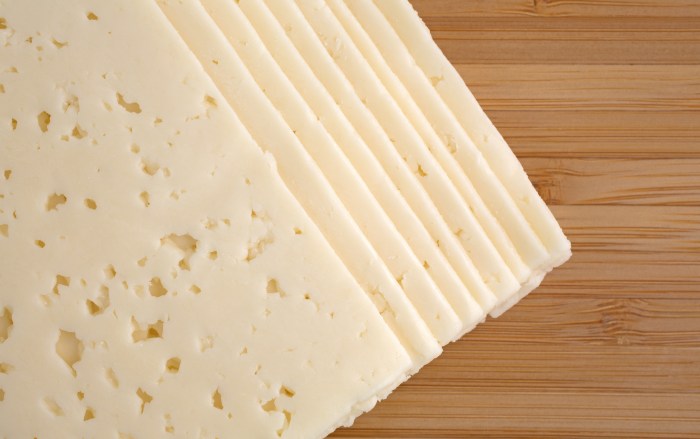Havarti Cheese Nutritional Profile

Havarti cheese nutrition data – Havarti, a semi-soft cheese originating in Denmark, offers a creamy texture and mild flavor, making it a popular addition to sandwiches, salads, and cheese boards. Understanding its nutritional profile is key to incorporating it effectively into a balanced diet. This section details the macronutrient and micronutrient composition of Havarti cheese, exploring variations across different fat content levels.
Macronutrient Composition of Havarti Cheese
The macronutrient content of Havarti cheese varies depending on the fat content. The following table presents a typical nutritional breakdown for a one-ounce (approximately 28g) serving of full-fat Havarti cheese. Note that values may slightly differ based on the manufacturer and specific production methods.
Havarti cheese, with its buttery texture and mild flavor, boasts a surprisingly high calcium content, a fact often overshadowed by richer cheeses. However, considering the caloric impact of dairy, one might compare it to the nutritional profile of a bagel with cream cheese, readily available information on which can be found here: bagel with cream cheese nutrition.
Returning to Havarti, understanding its nutritional data allows for mindful inclusion in a balanced diet, ensuring its creamy goodness doesn’t compromise health goals.
| Nutrient | Amount per Serving | % Daily Value | Unit of Measurement |
|---|---|---|---|
| Fat | 8g | 12% | grams |
| Protein | 7g | 14% | grams |
| Carbohydrate | 1g | <1% | grams |
Micronutrient Content of Havarti Cheese
Havarti cheese, like many dairy products, is a source of several essential vitamins and minerals. These contribute to overall health and well-being. The specific amounts can vary slightly based on the production process and the animal’s diet.
Havarti cheese provides:
- Vitamin A: Contributes to vision, immune function, and cell growth.
- Vitamin B12: Essential for nerve function, red blood cell formation, and DNA synthesis.
- Vitamin D: Crucial for calcium absorption, bone health, and immune function. The amount of Vitamin D can vary significantly depending on whether the cows were exposed to sunlight or supplemented with Vitamin D.
- Calcium: Essential for strong bones and teeth, muscle function, and nerve transmission.
- Phosphorus: Works with calcium for bone health and is involved in numerous metabolic processes.
- Riboflavin (B2): Plays a role in energy metabolism and cell function.
Nutritional Comparison of Havarti Cheese Varieties, Havarti cheese nutrition data
The nutritional profile of Havarti cheese changes significantly depending on the fat content. Reduced-fat and low-fat varieties aim to reduce the overall calorie and fat content while retaining some of the flavor and nutritional benefits. However, this often comes at the cost of reduced fat-soluble vitamins.
| Nutrient | Full-Fat Havarti | Reduced-Fat Havarti | Low-Fat Havarti |
|---|---|---|---|
| Fat (per ounce) | ~8g | ~5g | ~2g |
| Calories (per ounce) | ~100-110 | ~80-90 | ~60-70 |
| Protein (per ounce) | ~7g | ~7g | ~7g |
| Calcium (per ounce) | ~200mg | ~180-200mg | ~180-200mg |
Havarti Cheese and Dietary Considerations: Havarti Cheese Nutrition Data

Havarti cheese, with its creamy texture and mild flavor, presents a unique nutritional profile that warrants consideration within the context of various dietary approaches. Understanding its macronutrient composition and potential impact on health markers is crucial for informed dietary choices. This section will explore Havarti’s suitability for specific diets and its potential effects on cholesterol, blood pressure, and individuals with allergies.
Havarti Cheese and Ketogenic, Low-Carb, and High-Protein Diets
Havarti cheese can be a valuable component of ketogenic, low-carb, and high-protein diets due to its relatively high fat content and moderate protein levels. The fat content primarily contributes to satiety and provides energy, while the protein supports muscle maintenance and overall metabolic function. However, the carbohydrate content, though low, should still be factored into daily macronutrient targets.
For instance, a 1-ounce serving of Havarti cheese typically contains around 1-2 grams of carbohydrates, a negligible amount for many ketogenic dieters but still relevant for precise tracking. Individuals following strict low-carb or keto diets should consult their dietary guidelines and adjust their Havarti consumption accordingly to maintain their desired macronutrient ratios. The protein content, while not exceptionally high compared to some cheeses, still contributes to the overall protein intake of these diets.
Havarti Cheese and Cholesterol and Blood Pressure
The impact of Havarti cheese consumption on cholesterol and blood pressure is complex and depends on various factors, including individual genetics, overall diet, and pre-existing health conditions. Havarti, like other cheeses, contains saturated fat, which has been linked to elevated cholesterol levels in some studies. However, Havarti also contains beneficial nutrients, such as calcium and certain vitamins, that can play a role in maintaining cardiovascular health.
It’s important to note that the relationship between saturated fat intake and cholesterol levels is still under investigation, with some research suggesting a less pronounced effect than previously thought. Moderation is key; incorporating Havarti cheese as part of a balanced diet, rather than consuming large quantities, is generally recommended for managing cholesterol and blood pressure. Individuals with pre-existing cardiovascular conditions should consult their physician or a registered dietitian before significantly altering their dietary intake.
Havarti Cheese and Allergens
Havarti cheese, primarily made from cow’s milk, poses a significant risk for individuals with milk allergies. Cow’s milk allergy is a common food allergy, particularly in children, characterized by an immune system response to proteins found in cow’s milk. Symptoms can range from mild (e.g., hives, itching) to severe (e.g., anaphylaxis, requiring immediate medical attention). Individuals with milk allergies must strictly avoid Havarti cheese and other dairy products.
Furthermore, some Havarti cheeses may contain additional ingredients, such as enzymes used in the cheese-making process, that could trigger allergic reactions in sensitive individuals. Always carefully check the ingredient list to identify potential allergens and consult with a healthcare professional if you have concerns about potential allergic reactions. Proper labeling is crucial for individuals with allergies, ensuring they can make informed choices about their food consumption.
User Queries
Is Havarti cheese suitable for lactose-intolerant individuals?
Havarti cheese, like other cheeses, contains lactose, although the amount varies depending on the aging process. Lactose-intolerant individuals may experience varying levels of discomfort, and should proceed with caution, potentially consuming small amounts to assess their tolerance.
How does Havarti cheese compare to other cheeses in terms of sodium content?
The sodium content of Havarti cheese can vary depending on the brand and production method. It’s generally advisable to check the nutrition label for specific sodium information as it can be relatively high compared to some other cheeses.
Can Havarti cheese be part of a vegetarian or vegan diet?
Traditional Havarti cheese is not suitable for vegan diets as it is a dairy product. However, there may be vegan alternatives available on the market that aim to replicate the taste and texture of Havarti.


